Contents
Radish is a very popular vegetable, loved for its delicate sweetness with a slight spicy or bitter aftertaste. It contains many useful substances that strengthen the human immune system, make blood vessels healthy and elastic. But its main uniqueness is the possibility of year-round cultivation. Radishes in a greenhouse can be grown not only in early spring or late autumn, but also almost all year round, if you make a polycarbonate greenhouse, arrange lighting and heating to slightly extend the daylight hours.
Variety choice
Today, there are many varieties and hybrids of this vegetable, they differ in color, taste, size, yield, but the most important difference is the different ripening periods. Greenhouse radishes tend to take a little longer to grow than outdoors, so many prefer to plant very early varieties.
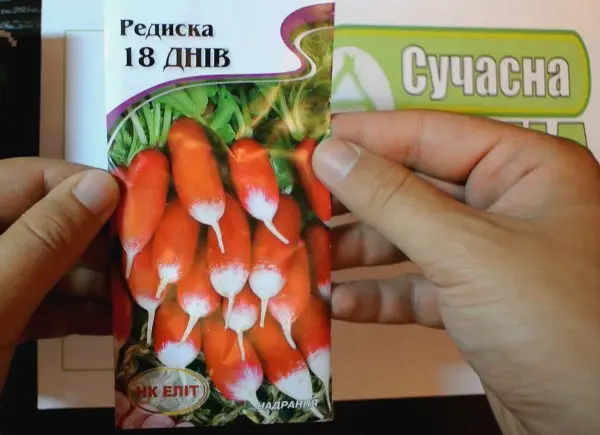
For example, Variety “18 days” refers to ultra-early. Its tender, mild-tasting cylindrical roots can be eaten as early as 18 days after sowing. Hybrids “Baby F1” and “Firstborn F1” ripen even on the 16th day, they are resistant to early bolting, form large red fruits with white flesh. “Firstborn F1” grows root crops up to 35 g and does not crack. “Ultra-early red” ripens in 18-20 days, its round red roots reach 15 g. Radishes of this variety eat not only roots, but also delicate tasty leaves with a high content of vitamin C.
Early ripe varieties ripen in 30 days even in a polycarbonate greenhouse. The most common of them are: “Heat”, “Early Red”, “Camelot”, “Ruby”, “Dawn”, “Helro”, “French Breakfast”, “Greenhouse”, “Greenhouse Gribovsky”. The last two, justifying their names, grow well in protected ground in autumn and early spring. “Helro” and “Zarya” are bred specifically to grow radishes in a greenhouse in winter. And the variety “Heat” does not need a high temperature at all, it grows well in the spring in a greenhouse.
Mid-season varieties “Vikhovsky white”, “Mokhovsky”, “Red giant” ripen in 30-40 days from the moment of sowing. Varieties that take more than 40 days to ripen are considered late, for example, “Dugansky”, “Zenith”.
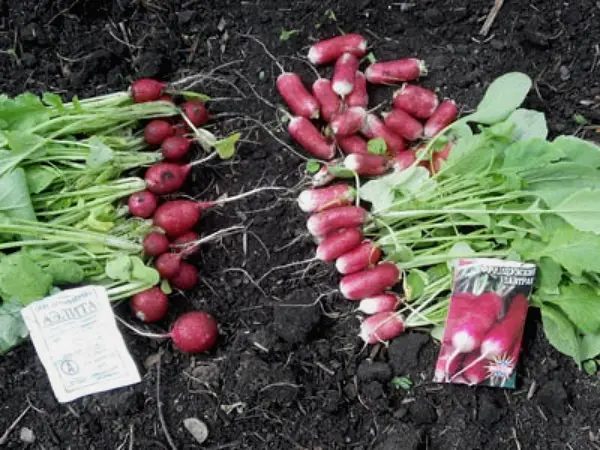
Radishes in a greenhouse grow without any problems and require traditional care. You can plant varieties of different ripening periods to enjoy fresh vitamin vegetables for a long time.
Planting radishes in greenhouse conditions
The soil where the radish will grow in the greenhouse is usually prepared in the fall. Having freed the beds from plant debris, the owners dig up the ground. Right after this, or at the same time as digging, you can add compost or humus. Since radishes in a greenhouse and open ground love non-acidic soils, with increased acidity, lime is added in autumn to deoxidize. If the soil is fertilized with mineral fertilizers, then superphosphate and potassium sulfur or potassium chloride are added. Well reduces acidity and saturates the soil with potassium wood ash, so it can replace potassium-containing mineral fertilizers. After fertilizing, the earth is thoroughly dug up, leveled and left until planting.
In the spring (or even in winter), before starting work, the earth just needs to be loosened. If the earth has not yet thawed enough for sowing, then it must be spilled with boiling water and covered with a film for 3-4 days, and only then sowed. This method will perfectly prepare the land, on the beds of polycarbonate greenhouses, for the early cultivation of vegetables.
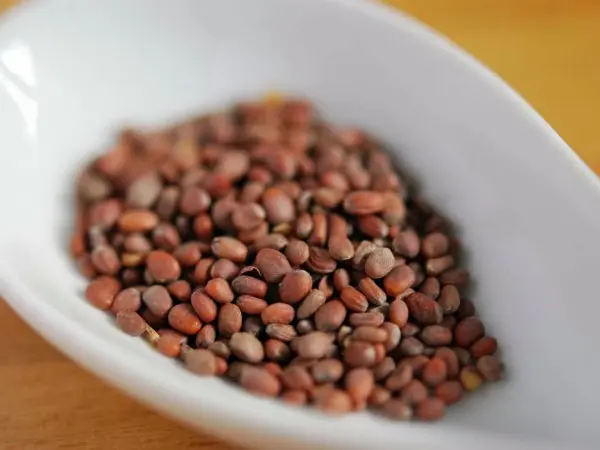
It is better to take the largest seeds, and leave the small ones for open ground, so they are sifted through a sieve with 2-3 mm cells. The selected seeds are wrapped with gauze or placed in a bag, and kept for 20 minutes in a pink solution of potassium permanganate, then washed, and soaked for 4 hours with a growth stimulant solution. Disinfected and increased yields in this way, the seeds are washed with clean water and scattered for drying to such a state that they do not stick to the fingers.
Radishes in a greenhouse are sown in rows every 7–8 cm. They make small indentations (no more than 1 cm), water them with warm water, then place the seeds in them at a distance of 2–3 cm from each other so that they do not have to break through later. Seeds germinate at a temperature of +16 or +18 degrees. But after the appearance of the leaves, it is advisable to lower the temperature for 3 days to +10, so that the sprouts do not stretch too much. After that, they return to +16 or +20.
Care of seedlings
When grown in a polycarbonate greenhouse, radishes do not require much care. It needs to be watered, broken through if necessary, fed, if the soil is not fertilized enough, protected from pests. Some gardeners mulch their beds.
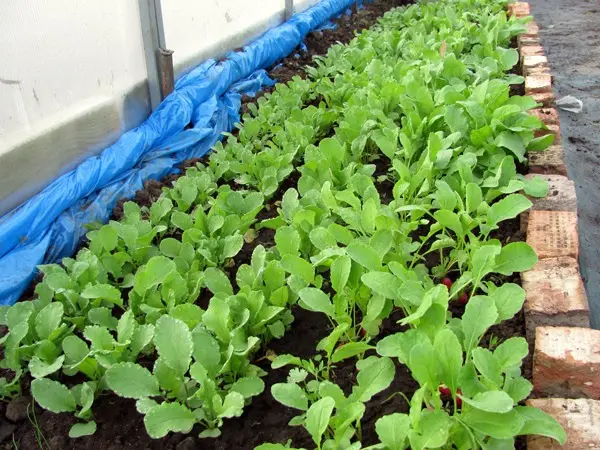
Radishes do not like long daylight hours if it lasts more than 12 hours, that is, the threat of shooting. But when growing in late autumn or winter, another problem will arise – insufficient daylight hours. Therefore, early in the morning or in the evening, after sunset, lighting is turned on in greenhouses.
Radish in a greenhouse is sometimes sown not in rows in the garden, but in egg cassettes. Gardeners collect cardboard egg cassettes (trays), cut or remove the bottoms, lay them out on the garden bed, slightly pressing them into the ground, sow each seed in its nest. From above, the seeds are covered with sand.
This original method has already been tested by many gardeners; it is suitable not only for greenhouses, but also for open ground. Growing using egg cassettes, according to its adherents, greatly simplifies the care of vegetables. Plants do not need to be thinned or weeded. Cardboard plays the role of a kind of mulch, retains moisture and protects against pests. However, it gets wet from watering and spreads gruel. Meanwhile, the harvest from egg cassettes looks much cleaner and neater, and pests do not get to it. Perhaps you need to plant 2 seeds in each nest, and then leave a stronger sprout if both sprout.
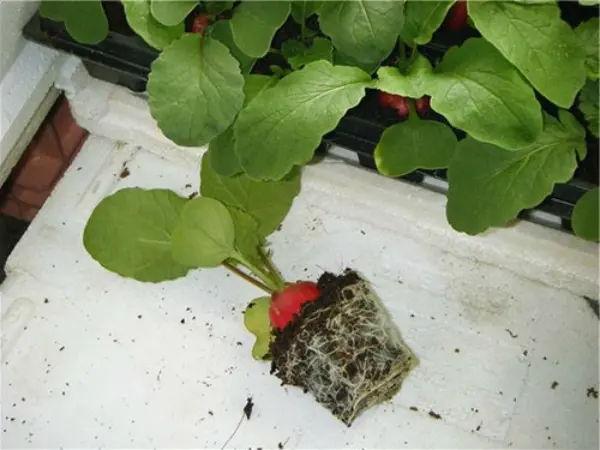
Watering
Radishes love moisture. If the earth dries out for at least one day, then the crop will lose quality, the roots will become tough and bitterness will be added. Therefore, you need to water often, usually it happens once every few days, but it is important to check the moisture content of the soil at the root level, it happens that watering is carried out daily, and if the sun warms up, then a couple of times a day. That is, you need to water as needed. But the conditions of a polycarbonate greenhouse contribute to an increase in overall humidity, which is fraught with decay or the appearance of fungal diseases. Therefore, mandatory care includes ventilation for at least 10 minutes after each watering.
Temperature conditions
Cold-resistant culture is able to tolerate light frosts. Seeds can sprout at a temperature of +2 degrees. But at an air temperature of +16 they will do it faster. The first days after the emergence of seedlings, it is lowered so that the sprouts do not stretch out, and then the air temperature will be optimal in the region of +20. At the same time, the earth should be warm all the time, not less than +16 degrees, even the first days it should remain at a level of +11 to + 14 degrees. Such conditions will allow friendly seedlings to appear, and then a wonderful harvest.
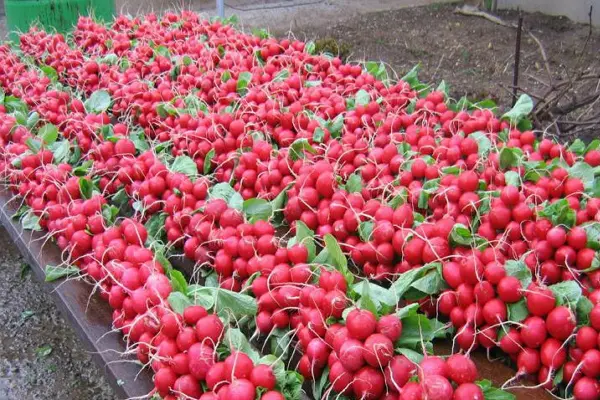
Harvesting and storage
Usually, all radishes of the same variety ripen approximately at the same time, which means that they need to be harvested in 1-2 days.
Before harvesting, radishes are watered: if watered in the morning, then it is better to clean in the afternoon, then the root crops will be juicy.
To keep the harvest fresh for several days, it is stored along with leaves and roots. If you need to keep the roots for 3 or 4 weeks, they are cleaned of tops and roots, washed, dried with towels and put in plastic bags. Closed bags are kept in the refrigerator.
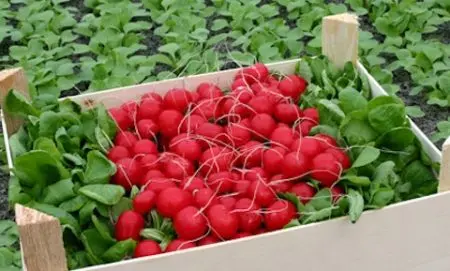
For long-term storage of radishes, a cellar is used: it is sprinkled with a mixture of sand and peat, and placed in boxes. You can simply lay it out on the shelves, sprinkled with dry sand or sawdust. It is very important to ventilate the room so that the humidity does not rise. Greenhouse radish under such conditions can be stored for several months, gradually losing its juiciness and taste (also healthy) qualities.
Video “Growing radishes”
This video is about the secrets of growing radishes. You will learn which varieties to choose, when to sow and how to care for the crop so that the harvest is good.









